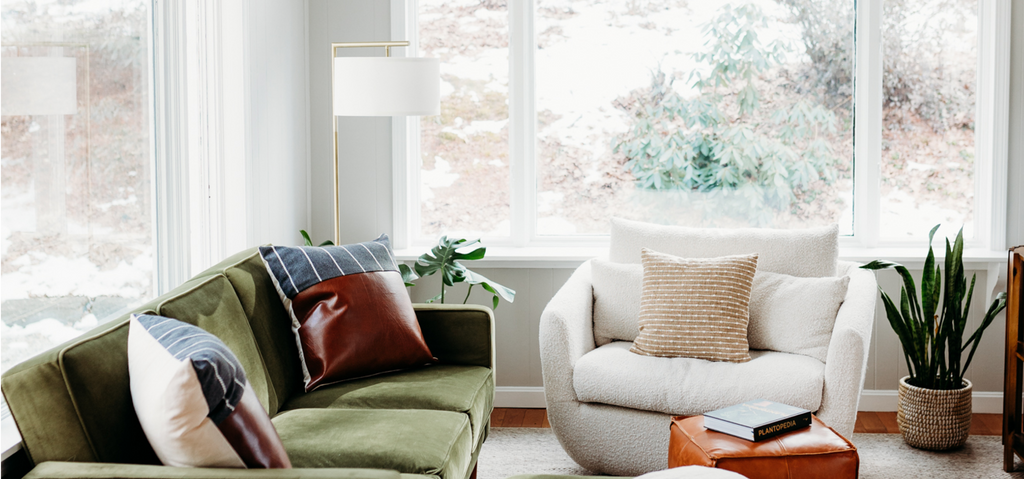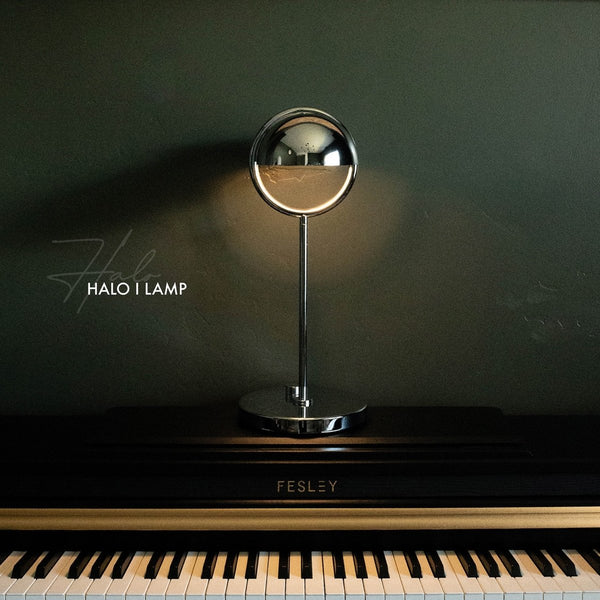Placing a floor lamp optimally within any room of your house follows a straightforward principle. For a room that's well-illuminated, it's recommended to have a total of three light sources, excluding the daylight from windows.
The initial source is the overhead light. To create an atmosphere of coziness and warmth, you require an additional two sources. Survey your room and pinpoint areas that lack sufficient light. Once these spots are identified, you'll have a clear indication of where to position your living room's floor lamp.
Floor lamps work in so many spots all over your home. While they don’t belong out in the middle of a room, they work splendidly when tucked in any of these spaces:
- Next to a sofa, chair or bed
- Used as a spotlight
- Beside a desk
- Next to a mirror for maximum impact
- Beside any table or cabinet
- In front of an accent wall, or standing on its own as an accent lamp
Check Out The Floor Lamp In this Set Up
Assessing the Lighting Needs of Your Living Room
You might have identified the perfect spot, however, for optimal illumination, you need to assess the lighting requirements of your living room. Lighting requirements can vary based on personal preferences and specific tasks. Here's how you can assess the lighting requirements of your living room:
Identify Room Function and Activities:
Different activities require different lighting levels and types. For example, a kitchen, office, or reading area may need brighter task lighting, while a living room or bedroom might benefit from softer, ambient lighting.
Calculate Room Size:
Measure the dimensions of the room (length, width, and height) to calculate its square footage. Lighting requirements are often specified in terms of lumens per square foot (or lux for metric measurements).
Determine Lighting Level:
Research the recommended lighting levels for the room's function. Lighting standards can vary, but here are some general guidelines:
- Ambient (general) lighting: 20-30 lumens per square foot (215-320 lux)
- Task lighting: 50-75 lumens per square foot (540-810 lux)
- Accent lighting: Varies based on decorative intent
Create a Lighting Plan:
Design a lighting plan that combines ambient, task, and accent lighting as needed. Consider layering different types of lighting to achieve a balanced and versatile lighting scheme. For instance, a living room might have a combination of overhead ambient lighting, floor lamps for ambient and task lighting, and wall sconces for accent lighting.
Natural Light Integration:
Consider the room's natural light sources, such as windows and skylights. Take into account how natural light changes throughout the day and how it interacts with artificial lighting.
Test and Adjust:
After installing the lighting, test the setup and make any necessary adjustments to achieve the desired lighting effects and functionality.
Determining the Number of Floor Lamps to Use
The next step is to determine how many floor lamps your living room needs. Let’s begin with some helpful tips:
1. The number of floor lamps in your living room varies depending on the size of the room, existing lighting, and your desired lighting levels.
2. You can use multiple floor lamps to create a layered lighting effect and enhance the room's overall ambiance. You can create a layered lighting effect by combining floor lamps with other lighting sources such as fixtures and table lamps.
- In the case of chandeliers, you need to create a whole lighting plan so that neither of the light sources cancels the other.
3. How do I avoid over-lighting or under-lighting the room?
- Consider the brightness and coverage area of each floor lamp and adjust the number accordingly to achieve the right balance.
Check Out More about This Floor Lamp
Guidelines for Determining the Number of Floor Lamps:
-
Living Room Size: In larger living rooms, multiple floor lamps may be necessary to ensure even illumination. As a general rule, consider one floor lamp for every 100 square feet of living space.
-
Furniture Arrangement: Arrange the floor lamps strategically to fill in dark corners or areas that might be poorly lit by other fixtures. For larger seating areas, consider placing a floor lamp near each seating cluster.
- Personal Preferences: Take into account your preferred lighting levels and the activities you frequently engage in. If you enjoy reading, you may want more task lighting near reading nooks or chairs.
Strategic Placement Ideas for Floor Lamps
Strategic placement of floor lamps in the living room can create various lighting effects and enhance the overall ambiance. Here are some placement ideas to achieve different lighting effects and highlight specific areas:
Reading Corners:
Place a floor lamp with an adjustable arm next to a cozy armchair or reading nook, providing focused task lighting for comfortable reading sessions.
Accentuating Artwork:
Position a floor lamp with an adjustable spotlight near paintings, sculptures, or other artwork.
Illuminating Architectural Features:
Use floor lamps to highlight architectural elements, such as pillars, columns, or decorative moldings, creating dramatic shadows and depth, enhancing the room's visual appeal.
Behind Furniture:
Position floor lamps behind sofas, console tables, or entertainment centers to add a layer of soft ambient light to the living room.
Symmetrical Arrangement:
For a balanced and symmetrical look, use two identical floor lamps on either side of a central focal point, such as a fireplace or TV unit. This placement creates a sense of harmony and elegance.
Utilizing Floor Lamps for Functional and Decorative Purposes
Floor lamps are incredibly versatile and serve both functional and decorative purposes in interior design. They offer practical lighting solutions for various activities while adding style and aesthetic appeal to the living space. A floor lamp can offer you ambient, task, and accent lighting while simultaneously providing various choices in terms of design and style. Unlike table lamps or chandeliers, floor lamps take up minimal space and can be placed in tight corners or small areas. Furthermore, easy installation means you do not require wall mounting or ceiling wiring, making them convenient to use in any room.
Some of the functional aspects of a floor lamp include:
- Crafting and Hobbies: Floor lamps with bright and adjustable light are excellent for crafting, sewing, or any detailed work that requires good visibility. For instance; Archiology’s Arc floor lamps can be standout pieces in your living room offering functionality as well as design.
- Ambient Lighting: Use floor lamps with soft, diffused light to create a warm and inviting ambiance in the living room or bedroom. Archiology’s modern and stylish lamps provide soft and ambient lighting.
- Nighttime Illumination: Floor lamps near the bed or hallway can serve as a gentle night light for easy navigation during nighttime. Archiology offers you versatile floor lamps that can cater to your specific needs as well as serve as style statements. Their unique shapes, materials, and finishes make them conversation starters and focal points in the room.
Harmonizing Floor Lamps with Existing Decor
All the thought and effort put into curating and placing the perfect floor lamps will be of no use if your floor lamps do not harmonize with the existing décor of your living room. Harmonizing floor lamps with existing decor is essential to create a cohesive and visually pleasing living room. Let’s explore how you can create a perfectly harmonized look and what factors are essential in creating one.
Consider the Living Room Style:
Identify the predominant style of your living room, such as modern, traditional, industrial, bohemian, or minimalist. Choose floor lamps that align with this style or offer a complementary contrast.
Size and Scale:
Large, bold lamps work well in spacious rooms with high ceilings, while smaller lamps are better suited for cozier spaces.
Shape and Silhouette:
Consider the lamp's shape and silhouette in relation to the existing furniture and architectural features. For instance, if your furniture has clean lines, opt for floor lamps with sleek and modern designs. Lamps with fabric shades create softer, diffused lighting, while metal or glass shades provide a more focused and directional light.
Color, Material, and Finish:
Choose floor lamps with colors or finishes that harmonize with the color scheme and textures in the room.
Coordination with Other Lighting Fixtures:
Integrate floor lamps with other lighting fixtures in the room to create a harmonious lighting design.

Floor lamps are versatile additions to any living space, fulfilling both functional and decorative roles. However, you might not be able to achieve their true potential if you do not consider the placement and other important aspects. Archiology's range of stylish floor lamps exemplifies this versatility, providing attractive design elements that can serve as conversation starters and enhance the overall interior décor.











